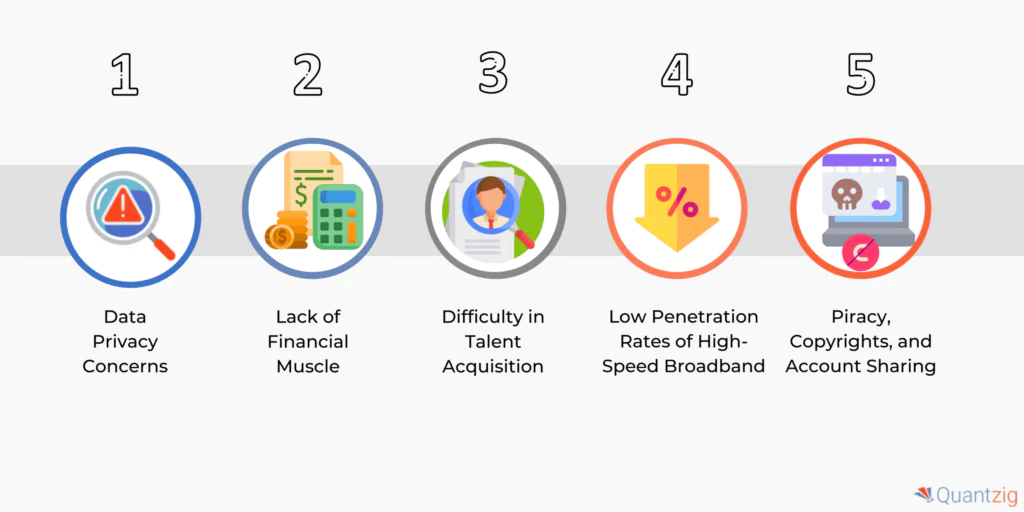Table of Contents
Big Data Analytics Case Study in the Media & Entertainment Industry:
The media and entertainment industry has witnessed intense competition and pressure in recent years. As a result, many organizations are now adopting a customer-centric approach to enhance customer experience and reduce attrition. With shifting audience preferences, staying ahead requires more than just content creation—companies must leverage big data analytics to better understand and engage their audience.
However, implementing big data analytics is a complex challenge that involves managing and analyzing vast amounts of data. To improve performance and drive efficiency, organizations need the capability to access, analyze, and interpret large data volumes effectively. In this write-up, we’ll explore real-world use cases of big data analytics in the media and entertainment industry, highlighting one such successful case from Quantzig.
Book a demo to experience the meaningful insights we derive from data through our analytical tools and platform capabilities.
Request a DemoThe Complex Media and Entertainment Industry – Overview
The media and entertainment industry is growing at an unprecedented rate, with companies finding it difficult to keep up with the pace. The challenges arise due to pressures to keep the costs down while trying to improve revenues. Further complications arise as the media consumption habits of customers are highly fragmented.
The trend of one big company dominating the market is gradually fading away, providing an opportunity for small players to complete successfully. One of the most significant trends observed in the media industry is the shift in media platforms from traditional channels to online mediums.
As a result, it paves the way for the media industry to implement big data and data analytics technology to gain more profound audience insights. With a new source of data available to the media companies each day, companies can efficiently understand customer needs and deliver content that pleases the audience. However, with the rapid adoption of digital technologies, the media industry does face a few big data challenges which slow down their progression. To fully realize the potential of digital technologies, companies should successfully tackle these big data challenges.
How the Media and Entertainment Industry is Tackling Big Data Hurdles
The Media and Entertainment industry faces unique challenges with big data, but innovative strategies are helping to overcome these hurdles. Here’s a look at how the industry is addressing these challenges:
| Challenge | Solution Based on Quantzig Services |
|---|---|
| Data Integration | Implement advanced data management platforms provided by Quantzig to unify diverse data sources for a comprehensive view. |
| Real-time Analytics | Utilize real-time analytics tools from Quantzig to process data instantly, enabling dynamic content recommendations. |
| Data Security | Adopt robust security measures from Quantzig, including encryption and secure access controls to protect sensitive data. |
| Audience Segmentation | Leverage sophisticated analytics and machine learning models by Quantzig to create detailed audience profiles. |
| Scalability | Embrace scalable cloud solutions offered by Quantzig to handle the growing volume of data efficiently. |
| Content Monetization | Apply data-driven insights from Quantzig to optimize pricing strategies, ad placements, and subscription models. |
| Predictive Analytics | Employ predictive analytics solutions from Quantzig to forecast trends and make informed content creation decisions. |
Quantzig’s tailored solutions are essential in addressing big data challenges in the Media and Entertainment industry, ensuring effective data management, real-time insights, and strategic decision-making.
Not only this, there are various factors that also influence the growth of the media and entertainment industry with Big data analytics:
Staying Relevant in a New Digital Landscape: Players within the media and entertainment industry must increase their focus on shifting to a more of an audience-based approach driven by data inputs to stay relevant in today’s competitive landscape. Additionally, big data, storage, and the ability to deliver real-time communications or offers are expected to evolve the relationship between consumer and marketer.
Mobile Compatibility: Today, due to the rise in mobile technology, media portals need to have a strong mobile presence to keep pace with the changing lifestyle. As a result, developing a responsive web design is crucial for companies.
Experience the advantages firsthand by testing a customized complimentary pilot designed to address your specific requirements.
Request a free pilotChallenges of big data analytics in the Media & Entertainment Industry

Use Cases of Inventory Control Management in the M&E Industry:
| Challenges/Opportunities | Details |
|---|---|
| Superior Data Privacy | Recent data leaks have raised consumer concerns about data usage. Regulations now demand better data management, making accurate analysis challenging. Big data analytics solutions help overcome these hurdles. |
| Financial Constraints | Media start-ups and SMEs face high costs for data storage, infrastructure, processing, and human resources. Cloud storage and SaaS solutions provide affordable alternatives. |
| Talent Acquisition Complexity | There’s a global shortage of skilled data scientists. Quantzig bridges this gap by providing expert analytics services to meet industry demands. |
| Broadband Penetration | Limited high-speed broadband coverage restricts customer data collection to urban areas. Big data analytics helps efficiently gather and analyze consumer insights despite these challenges. |
| Predicting Audience Interests | Media companies collect vast user data through services like live streaming and pay-per-view. Big data analytics uncovers insights about user behavior, improving content alignment. |
| Scheduling Media Streams | Big data connects media distributors directly with end-users, optimizing scheduled streaming and identifying content preferences to maximize engagement and profits. |
Big data analytics is transforming the media and entertainment landscape. Quantzig’s advanced solutions empower businesses to address challenges, predict trends, and optimize operations for sustainable growth.
Read More: How Artificial Intelligence is Disrupting the Media and Entertainment Sector
How big data is used in the media and entertainment industry?
Big data has transformed the media and entertainment industry by providing powerful tools to improve audience engagement and optimize content strategies. Through the analysis of vast datasets, media companies can gain a deeper understanding of their audience, enhance personalization, and make data-driven decisions that improve overall business performance. Below are some key ways big data is impacting the industry:
| Activity | Description |
|---|---|
| Content Creation | Involves producing films, TV shows, music, literature, news, and digital media. Writers, directors, and content creators craft engaging material for audiences. |
| Distribution and Broadcasting | Focuses on delivering content via TV networks, radio, streaming platforms, theaters, and print publications, ensuring content reaches its audience and generates revenue. |
| Advertising and Marketing | Promotes content and products through campaigns, media buying, and brand awareness efforts to attract and retain audience interest. |
| Digital Transformation | Involves adapting to digital media trends, distributing content through online platforms and social media, catering to the demand for on-demand and mobile consumption. |
These activities not only shape the industry but also drive its continuous evolution. As technological advancements and shifting consumer behaviors influence the sector, companies must remain agile and innovative to stay competitive in this rapidly changing landscape.
Get started with your complimentary trial today and delve into our platform without any obligations. Explore our wide range of customized, consumption-driven analytical solutions services built across the analytical maturity levels.
Start your free trialThe Future of Big Data in Media: Key Challenges and Solutions
The media landscape is evolving rapidly, with big data playing an increasingly critical role in shaping content creation, audience engagement, and monetization strategies. However, as the volume and complexity of data grow, so do the challenges media companies face in managing and utilizing this wealth of information. Below is an overview of key challenges the industry encounters and how Quantzig’s solutions address them effectively:
| Key Challenge | Description | Solution (Basis Quantzig’s Services) |
|---|---|---|
| Data Fragmentation | Multiple data sources make it hard to obtain a unified view of audience preferences and behaviors. | Quantzig’s data integration services streamline and unify disparate data sources, offering a comprehensive, real-time view of customer behaviors across platforms. |
| Real-Time Personalization | Delivering personalized content in real-time is difficult with traditional data processing methods. | Quantzig leverages real-time analytics and AI-based insights to enable immediate data processing and deliver personalized content in real-time to boost engagement. |
| Data Privacy and Compliance | Protecting user data while adhering to strict regulatory frameworks remains a top concern. | Quantzig’s data governance solutions ensure compliance with global regulations by implementing robust privacy frameworks and data encryption strategies. |
| Scalability of Data Infrastructure | Managing and scaling infrastructure to handle growing data volumes is challenging and costly. | Quantzig’s cloud-based data management solutions provide scalable platforms that easily adapt to increasing data volumes without compromising performance or costs. |
| Audience Segmentation and Targeting | Identifying and targeting specific audience segments requires sophisticated tools and methods. | Quantzig offers advanced segmentation and audience analytics services, enabling media companies to target the right content to the right audience segments effectively. |
| Monetizing Data | Turning data insights into actionable revenue-generating strategies can be complex. | Quantzig’s data monetization services help optimize ad placements, pricing strategies, and subscription models using data-driven insights, boosting revenue streams. |
| Predictive Insights for Content | Anticipating future trends and content preferences is difficult with constantly changing consumer tastes. | Quantzig’s predictive analytics and machine learning models allow media companies to forecast trends, improving content creation and distribution strategies. |
Conclusion:
By addressing these challenges through advanced big data analytics , Quantzig empowers media companies to leverage big data effectively, enabling smarter decision-making, optimized content strategies, and increased profitability in a rapidly changing industry.




